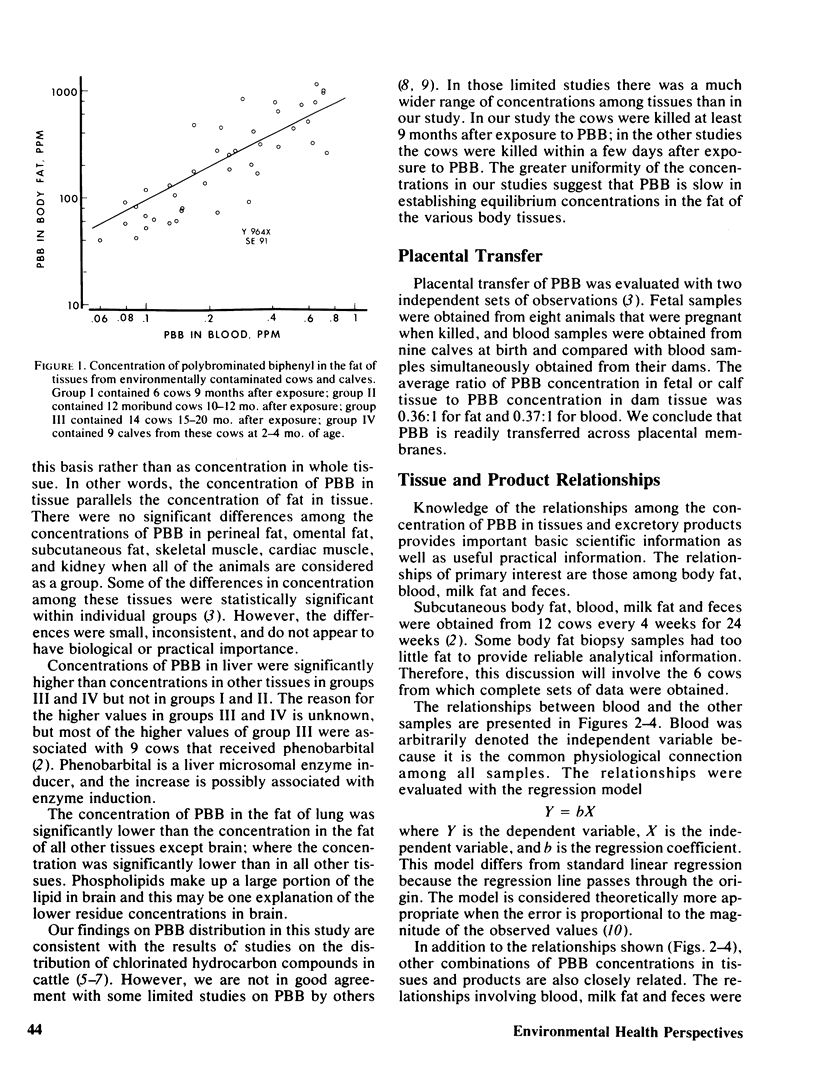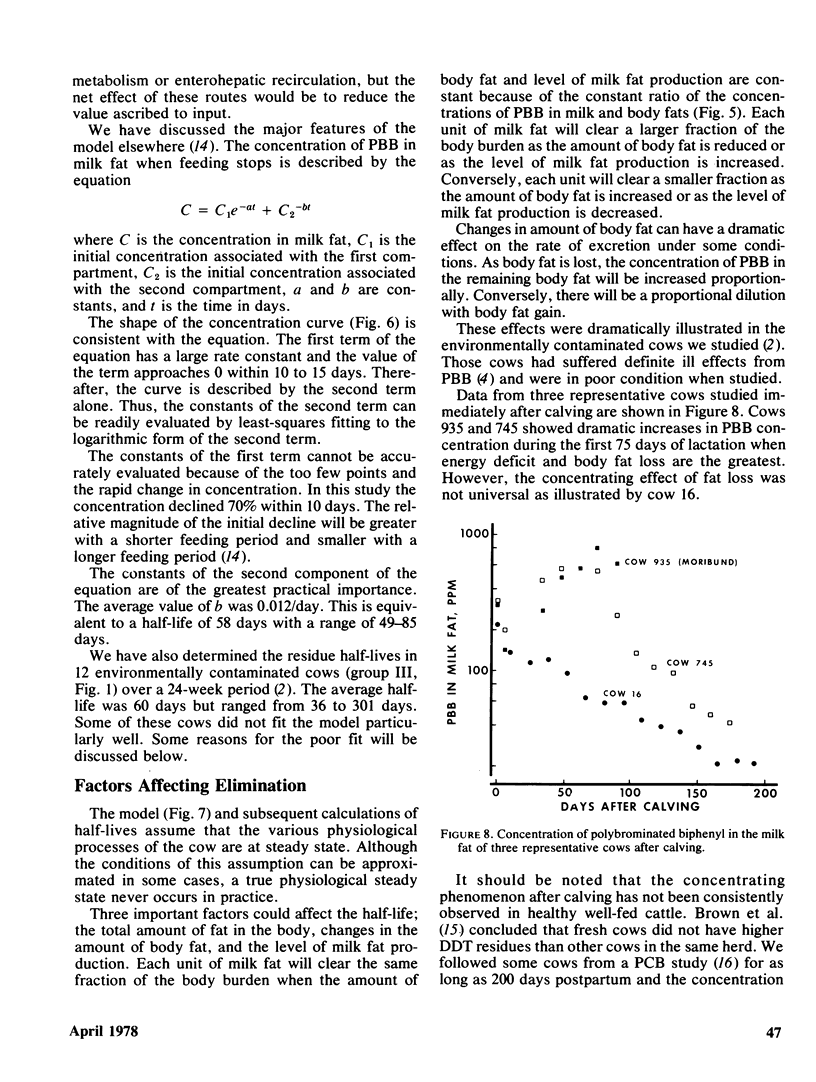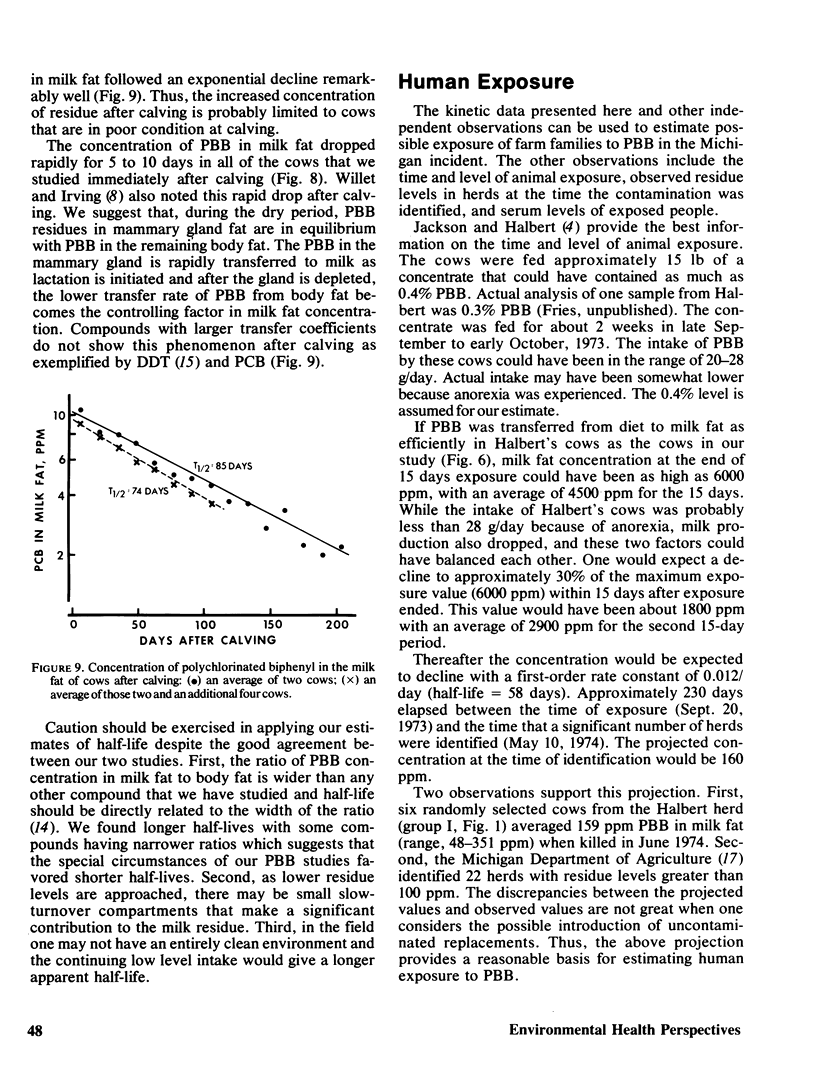Abstract
Cows fed a constant amount of polybrominated biphenyl (PBB) reached a steady-state concentration in milk fat within 30 days. This concentration was approximately four times the concentration in the total diet. When feeding of PBB was stopped, the concentration in milk was adequately described as a sum of two first-order elimination rates. Biological half-life in environmentally contaminated cows, studied for 6 months about a year after contamination, was 60 days. The stage of lactation affected the rate of elimination, and in some concentrations increased shortly after calving. Residues were distributed in body tissues proportionally to concentration of fat in the tissues. Liver and brain were exceptions. Concentration in liver fat was generally higher than other tissues and possibly related to the treatment of some cows with phenobarbital. Residues in brain fat were significantly lower than all other tissues. The ratio of the concentrations in milk fat to concentration of residues in the blood of calves and fat of fetal tissues to the concentration in the corresponding tissue in the dams was 0.36:1. It was estimated that people consuming milk from the highly contaminated Michigan cows could have received PBB doses as great as 10 g from this source alone.
Full text
PDF







Selected References
These references are in PubMed. This may not be the complete list of references from this article.
- Fries G. F., Cecil H. C., Bitman J., Lillie R. J. Rention and excretion of polybrominated biphenyls by hens. Bull Environ Contam Toxicol. 1976 Mar;15(3):278–282. doi: 10.1007/BF01812636. [DOI] [PubMed] [Google Scholar]
- Fries G. F., Lillie R. J., Cecil H. C., Bitman J. Retention and excretion of polychlorinated biphenyl residues by laying hens. Poult Sci. 1977 Jul;56(4):1275–1280. doi: 10.3382/ps.0561275. [DOI] [PubMed] [Google Scholar]
- Fries G. F., Marrow G. S. Distribution of hexachlorobenzene residues in beef steers. J Anim Sci. 1977 Nov;45(5):1160–1165. doi: 10.2527/jas1977.4551160x. [DOI] [PubMed] [Google Scholar]
- Fries G. F., Marrow G. S. Excretion of polybrominated biphenyls into the milk of cows. J Dairy Sci. 1975 Jun;58(6):947–951. doi: 10.3168/jds.S0022-0302(75)84661-3. [DOI] [PubMed] [Google Scholar]
- Fries G. F., Marrow G. S., Jr, Gordon C. H. Long-term studies of residue retention and excretion by cows fed a polychlorinated biphenyl (Aroclor 1254). J Agric Food Chem. 1973 Jan-Feb;21(1):117–121. doi: 10.1021/jf60185a012. [DOI] [PubMed] [Google Scholar]
- Gutenmann W. H., Lisk D. J. Tissue storage and excretion in milk of polybrominated biphenyls in ruminants. J Agric Food Chem. 1975 Sep-Oct;23(5):1005–1007. doi: 10.1021/jf60201a008. [DOI] [PubMed] [Google Scholar]
- Jackson T. F., Halbert F. L. A toxic syndrome associated with the feeding of polybrominated biphenyl-contaminated protein concentrate to dairy cattle. J Am Vet Med Assoc. 1974 Sep 1;165(5):437–439. [PubMed] [Google Scholar]
- Rumsey T. S., Bond J. Effect of urea, diethylstilbestrol, and type of diet on the distribution of aldrin and dieldrin residues in finished beef heifers. J Agric Food Chem. 1974 Jul-Aug;22(4):664–667. doi: 10.1021/jf60194a034. [DOI] [PubMed] [Google Scholar]
- Willett L. B., Irving H. A. Distribution and clearance of polybrominated biphenyls in cows and calves. J Dairy Sci. 1976 Aug;59(8):1429–1439. doi: 10.3168/jds.S0022-0302(76)84381-0. [DOI] [PubMed] [Google Scholar]


